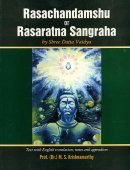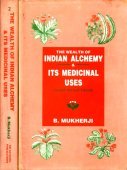Upadhatu, Upadhātu: 12 definitions
Introduction:
Upadhatu means something in Hinduism, Sanskrit, Marathi. If you want to know the exact meaning, history, etymology or English translation of this term then check out the descriptions on this page. Add your comment or reference to a book if you want to contribute to this summary article.
In Hinduism
Ayurveda (science of life)
Source: Wisdom Library: Āyurveda and botanyUpadhātu (उपधातु) is a Sanskrit terchnical term referring to “subsidiary tissues” and is used throughout Ayurvedic literature such as the Carakasaṃhitā and the Suśrutasaṃhita.
Source: Hand book of domestic medicine: Basic principles of ĀyurvedaUpadhātu are actually not nourishing the body but they are the bye products of Dhātu, necessary for supporting the body.
They are
- Stanya (breast milk),
- Ārtava (menstrual blood),
- Kaṇḍarā (tendons),
- Śirā (vessels),
- Vasā (fat),
- Tvak (skin),
- Snāyu etc.
They are also vitiated by Doṣa.
Source: gurumukhi.ru: Ayurveda glossary of termsUpadhātu (उपधातु):—The minor structural componants that stabilize and sustain the body.

Āyurveda (आयुर्वेद, ayurveda) is a branch of Indian science dealing with medicine, herbalism, taxology, anatomy, surgery, alchemy and related topics. Traditional practice of Āyurveda in ancient India dates back to at least the first millenium BC. Literature is commonly written in Sanskrit using various poetic metres.
Languages of India and abroad
Marathi-English dictionary
Source: DDSA: The Molesworth Marathi and English Dictionaryupadhātu (उपधातु).—m (S) A common term for the secondary or inferior metals. 2 A mineral or fossile body; a mineral in the restrained sense.
Source: DDSA: The Aryabhusan school dictionary, Marathi-Englishupadhātu (उपधातु).—f A secondary or inferior metal.
Marathi is an Indo-European language having over 70 million native speakers people in (predominantly) Maharashtra India. Marathi, like many other Indo-Aryan languages, evolved from early forms of Prakrit, which itself is a subset of Sanskrit, one of the most ancient languages of the world.
Sanskrit dictionary
Source: DDSA: The practical Sanskrit-English dictionaryUpadhātu (उपधातु).—
1) An inferior metal, semi-metal. They are seven; सप्तोपधातवः स्वर्णं माक्षिकं तारमाक्षिकम् । तुत्थं कांस्यं च रातिश्च सुन्दूरं च शिलाजतु (saptopadhātavaḥ svarṇaṃ mākṣikaṃ tāramākṣikam | tutthaṃ kāṃsyaṃ ca rātiśca sundūraṃ ca śilājatu) ||
2) A secondary secretion of the body (six in number); e. g. milk, menses, adeps, sweat, teeth, hair, and lymph; स्तन्यं रजो वसा स्वेदो दन्ताः केशास्त- थैव च । औजस्यं सप्तधातूनां क्रमात्सप्तोपधातवः (stanyaṃ rajo vasā svedo dantāḥ keśāsta- thaiva ca | aujasyaṃ saptadhātūnāṃ kramātsaptopadhātavaḥ) ||
Derivable forms: upadhātuḥ (उपधातुः).
Source: Cologne Digital Sanskrit Dictionaries: Shabda-Sagara Sanskrit-English DictionaryUpadhātu (उपधातु).—m.
(-tuḥ) 1. An inferior mineral, a semi-metal: seven are specified; pyrites, sulphate of copper, talc, antimony, red orpiment, yellow orpiment, and calx of brass. 2. Secondary secretion, as the milk, menses, adeps, sweet, teeth, hair, and lymph. E. upa minor, and ghātu mineral, &c.
Source: Cologne Digital Sanskrit Dictionaries: Monier-Williams Sanskrit-English Dictionary1) Upadhātu (उपधातु):—[=upa-dhātu] m. a secondary mineral, semi-metal (seven are specified: svarṇa-mākṣika, pyrites; tāra-mākṣika, a particular white mineral; tuttha, sulphate of copper; kāṃsya, brass; rīti, calx of brass; sindūra, red lead; śilājatu, red chalk), [Bhāvaprakāśa]
2) [v.s. ...] secondary secretions and constituents of the body (viz. the milk, menses, adeps, sweat, teeth, hair, and lymph), [Śārṅgadhara-saṃhitā etc.]
Source: Cologne Digital Sanskrit Dictionaries: Yates Sanskrit-English DictionaryUpadhātu (उपधातु):—[upa-dhātu] (tuḥ) 2. m. An inferior metal.
Source: DDSA: Paia-sadda-mahannavo; a comprehensive Prakrit Hindi dictionary (S)Upadhātu (उपधातु) in the Sanskrit language is related to the Prakrit word: Uvadhāu.
[Sanskrit to German]
Sanskrit, also spelled संस्कृतम् (saṃskṛtam), is an ancient language of India commonly seen as the grandmother of the Indo-European language family (even English!). Closely allied with Prakrit and Pali, Sanskrit is more exhaustive in both grammar and terms and has the most extensive collection of literature in the world, greatly surpassing its sister-languages Greek and Latin.
See also (Relevant definitions)
Ends with: Arupadhatu, Dhatupadhatu, Rupadhatu.
Full-text: Uvadhau, Vasa, Artava, Svarnamakshika, Stanya, Uparasa, Ojas, Dhatu.
Relevant text
Search found 3 books and stories containing Upadhatu, Upa-dhatu, Upa-dhātu, Upadhātu; (plurals include: Upadhatus, dhatus, dhātus, Upadhātus). You can also click to the full overview containing English textual excerpts. Below are direct links for the most relevant articles:
A History of Indian Philosophy Volume 2 (by Surendranath Dasgupta)
Part 7 - Growth and Disease < [Chapter XIII - Speculations in the Medical Schools]
Charaka Samhita and Sushruta Samhita (by Nayana Sharma)
Disease in the classical Saṃhitās < [Chapter 4]
Bhesajjakkhandhaka (Chapter on Medicine) (by Hin-tak Sik)
(b) Basic Principles of Āyurveda < [Chapter 2 - Background Information]
Related products

